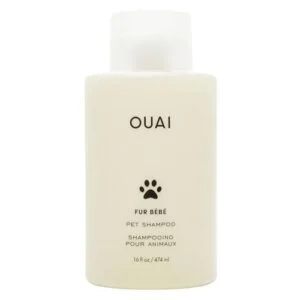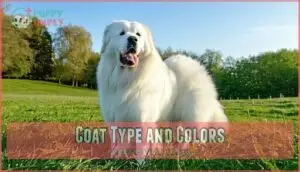This site is supported by our readers. We may earn a commission, at no cost to you, if you purchase through links.

These magnificent dogs weigh 85-160 pounds and sport gorgeous white double coats that make them look like fluffy clouds with attitude.
Originally bred to guard sheep in the mountains between France and Spain, they’re natural protectors with independent minds.
You’ll find they’re patient with kids but need consistent training and plenty of space to roam.
Their calm, regal nature masks a fierce loyalty to their family.
While they’re not apartment dogs, they make devoted companions for those who understand their guardian instincts.
There’s much more to keep in mind before welcoming one home.
Table Of Contents
- Key Takeaways
- Great Pyrenees Quick Facts
- What Does a Great Pyrenees Look Like
- Personality and Temperament of Great Pyrenees
- Health and Grooming Needs
- Are Great Pyrenees Good Family Dogs?
- 5 Best Essentials for Raising a Great Pyrenees
- Training and Exercise for Great Pyrenees
- Frequently Asked Questions (FAQs)
- Can Great Pyrenees be left alone all day?
- What are the common health issues that Great Pyrenees are prone to?
- How often should a Great Pyrenees be groomed?
- Are Great Pyrenees good with children?
- What is the recommended diet for a Great Pyrenees?
- How independent are Great Pyrenees and do they require a lot of training?
- How much does Great Pyrenees food cost monthly?
- Do Great Pyrenees shed year-round or seasonally?
- Can Great Pyrenees live in hot climates?
- What age should Great Pyrenees start guardian training?
- Conclusion
Key Takeaways
- You’ll need substantial space and patience – These 85-160 pound dogs aren’t apartment-friendly and require consistent training due to their independent, guardian nature.
- Their thick double coat demands regular maintenance – You’ll brush them 2-3 times weekly (daily during shedding seasons) and should budget $60-120 monthly for quality large-breed food.
- They’re excellent family protectors but need early socialization – While naturally gentle with children, you must socialize them before 16 weeks to prevent overprotective behaviors with strangers.
- Expect moderate exercise needs but significant health monitoring – They only need about an hour of daily activity, but you’ll face potential issues like hip dysplasia, bloat, and osteosarcoma throughout their 10-12 year lifespan.
Great Pyrenees Quick Facts
You’re about to discover everything you need to know about the majestic Great Pyrenees, from their ancient guardian roots to their gentle family nature.
This thorough guide covers their impressive size, protective instincts, and what it takes to care for these "gentle giants" in your home.
Breed Origins and History
Tracing back to Ancient Lineage in the Pyrenees Mountains between France and Spain, you’ll find the Great Pyrenees developed over millennia as Mountain Origins livestock guardians.
These Royal Guardians earned Historical Significance when French nobility adopted them, with King Louis XIV declaring them France’s royal dog in 1675.
The Pyrenean Mountain Dog’s Breed Development reflects centuries of selective breeding for protection and temperament.
Physical Characteristics
The Great Pyrenees’ impressive body size commands attention with males reaching 32 inches and females 25-29 inches tall.
Their powerful build supports weights from 85-160 pounds, designed for mountain work.
- Thick double coat provides weather protection with white base and possible gray or tan markings
- Eye color features distinctive dark brown, almond-shaped eyes set obliquely
- Ear shape includes small, V-shaped ears with rounded tips carried low
- Tail length extends well-plumed and low-set for balance
Popularity and Recognition
You’ll find the Great Pyrenees ranked 66th out of 202 breeds in popularity, reflecting their specialized guardian role rather than mainstream appeal.
The American Kennel Club officially recognized this ancient breed in 1933, acknowledging their historical significance as livestock protectors.
Their global popularity stems from proven working ability and gentle family nature, making them valued worldwide despite moderate breed recognition numbers.
Common Names and Nicknames
You’ll hear this breed called by many names across different regions and cultures.
The Great Pyrenees Club of America recognizes several official breed names, while mountain communities have developed their own affectionate monikers over centuries.
- Pyrenean Mountain Dog – Official breed names in European registries
- Ancient Titles – Patou, Montañés del Pirineo from historical records
- Royal Designation – France’s "Royal Dog" since 1675
- Mountain Monikers – PMD, GP, Pyr from working communities
- Nicknames Origin – "Gentle Giant" reflects their patient temperament
What Does a Great Pyrenees Look Like
When you first see a Great Pyrenees, you’ll notice their impressive size and striking white coat that makes them stand out in any crowd.
These majestic dogs combine powerful build with elegant features that reflect their mountain heritage and working dog background, showcasing their striking appearance.
Size and Weight Range
Understanding this massive breed’s dimensions helps you prepare for their impressive presence.
Males typically weigh 100-160 pounds and stand 27-32 inches tall, while females range 85-110 pounds at 25-29 inches.
These large breed dogs show significant Height Variations and Weight Factors between genders.
Growth Patterns continue until 18-24 months, making Size Comparisons with other large size dog breeds important for space planning and care requirements.
Coat Type and Colors
Your Pyrenees sports a thick double coat that’s naturally dirt-resistant and tangle-resistant.
The coat type features dense undercoat layers beneath long outer guard hairs. Coat colors range from pure white to white with gray, tan, or reddish-brown markings.
This double coat system requires regular grooming tips for proper coat maintenance, especially during shedding patterns when color genetics become visible.
Understanding the dog breed characteristics is essential for effective grooming and proper care.
Distinctive Features
Beyond their thick double coat, great pyrenees showcase distinctive facial features that make these gentle giants instantly recognizable.
You’ll notice their wedge-shaped head with dark brown, almond-shaped eyes that convey intelligence and calm confidence.
Their small, V-shaped ears hang close to the head, while their well-plumed tail curves gracefully.
This large breed’s body structure reflects their mountain heritage perfectly, showcasing a unique combination of traits that highlight their gentle giants nature.
Personality and Temperament of Great Pyrenees
You’ll discover that Great Pyrenees combine gentle family loyalty with strong guardian instincts passed down through centuries of mountain breeding.
These dogs show remarkable patience with children while maintaining protective alertness that requires proper socialization from an early age.
Typical Behavior Traits
Your dog’s impressive size reveals only part of their character.
These gentle giants combine fierce Guarding Instincts with remarkably calm demeanor, making independent decisions based on centuries of Pack Dynamics.
Their intelligent dogs’ nature shows through Territorial Marking behaviors and heightened Nighttime Activity.
As loyal dogs, they’ll patrol your property while maintaining Social Behavior that’s both protective dogs yet surprisingly patient with family members.
Child and Pet Friendliness
Great Pyrenees naturally excel with children and other pets, making them ideal family companions.
Their patient with children nature and gentle giant reputation stem from centuries of protective breeding.
Child Compatibility Guidelines:
- Kid Safety Tips – Supervise initial meetings between toddlers and your Pyr
- Child Socialization – Introduce children gradually during puppyhood for best results
- Pet Interaction – They’re typically calm around cats and smaller dogs when properly introduced
- Family Dynamics – Their familyfriendly temperament shines with consistent household rules
- Household Harmony – This dog breed childfriendliness requires early socialization training
Protective Instincts
How do these magnificent white giants transform from gentle companions into formidable guardians?
Your Great Pyrenees possesses deeply ingrained protective instincts that activate when they perceive threats to their family or territory.
| Guardian Trait | Description |
|---|---|
| Territorial Patrolling | Regularly walks property perimeters, marking boundaries |
| Alert Systems | Uses deep barking to warn of approaching strangers |
| Threat Response | Positions body between family and perceived danger |
| Defensive Mechanisms | Shows calm authority rather than aggressive confrontation |
These loyal companions excel as family protectors through their natural guarding behavior, inherited from centuries as livestock guardians.
Socialization Importance
Early Puppy Socialization shapes your Great Pyrenees’ entire behavioral development, preventing fear-based reactions that can last a lifetime.
Without proper socialization training, these gentle giants may become overly protective or anxious around strangers and new situations.
Essential socialization steps for raising confident canine companions:
- Expose your puppy to diverse people, sounds, and environments before 16 weeks – this critical window determines future social bonds
- Practice positive dog training with treats during new experiences – creating happy associations prevents behavioral issues
- Arrange controlled meetings with other dogs and pets – teaching appropriate canine social skills early
- Visit different locations weekly – building confidence through Fear Prevention techniques and gradual exposure
Consistent Dog Training during this period creates well-adjusted adults who balance their natural guardian instincts with appropriate social behavior.
Health and Grooming Needs
Great Pyrenees need regular health monitoring since they’re prone to hip dysplasia, bloat, and bone cancer that can seriously impact their quality of life.
You’ll want to establish a grooming routine early because their thick double coat requires consistent brushing to prevent matting and manage seasonal shedding.
Common Health Issues
Your Pyr’s gentle nature doesn’t shield them from serious health challenges.
Hip dysplasia affects joint alignment, while elbow dysplasia causes chronic pain. Osteosarcoma strikes aggressively, often requiring amputation.
Bloat prevention becomes life-saving knowledge for deep-chested breeds. Entropion treatment corrects painful eyelid rolling.
Degenerative myelopathy causes hind limb weakness. Gastric dilatation volvulus demands immediate emergency care.
Allergy management helps control skin irritations. Regular monitoring with health issue tools can help identify potential problems early on, which is critical for their health.
Recommended Health Tests
Proactive health screening helps you catch potential problems before they become serious concerns.
Your vet should perform a hip evaluation and elbow assessment to detect hip dysplasia and elbow dysplasia early.
An osteosarcoma screening checks for bone cancer risks, while a thyroid panel identifies hormonal imbalances.
These health tests provide health certification that confirms your dog’s genetic health status and helps prevent inherited genetic disorders from affecting future generations.
Grooming and Maintenance Tips
Regular grooming prevents matting and reduces shedding in your Great Pyrenees’ thick double coat.
Their weather-resistant fur requires specific care techniques to maintain health and comfort. For best results, understanding the proper use of a slicker brush tool is essential for their coat care.
- Brush Selection: Use a slicker brush and undercoat rake for effective coat care
- Shedding Control: Daily brushing during shedding seasons prevents fur tumbleweeds around your home
- Nail Trimming: Monthly clipping prevents overgrowth and discomfort during walks
- Bathing Tips: Bathe every 6-8 weeks with dog-specific shampoo to preserve natural oils
Lifespan and Longevity
Your Great Pyrenees will typically live 10-12 years, though proper care can extend their life expectancy.
Cancer causes over 40% of deaths in this breed, with osteosarcoma being particularly concerning. Heart conditions and joint issues also affect longevity factors.
As your dog enters the aging process, watch for mobility changes and schedule regular senior care checkups to monitor health issues and maintain quality of life. Understanding dog breed lifespans is essential for providing the best possible care for your Great Pyrenees.
Are Great Pyrenees Good Family Dogs?
You’re probably wondering if a Great Pyrenees will fit into your family life, especially with kids around.
These gentle giants are known for their patient, protective nature, but their size and independent streak require careful consideration before bringing one home.
Family Compatibility
Your family’s lifestyle determines whether a Great Pyrenees becomes your perfect companion or overwhelming challenge.
These gentle giants thrive in homes with consistent routines and patient family dynamics. Their natural protective instincts make them excellent family dogs when properly socialized, though their size requires careful consideration around smaller family members during Pet Interactions.
Home Adaptation depends on your space and commitment to Socialization Tips that guarantee family dog compatibility throughout their lives, ensuring a harmonious relationship between the dog and the family, which is crucial for a Great Pyrenees to become a perfect companion and not an overwhelming challenge.
Living With Children
Your Great Pyrenees naturally excels with children thanks to their gentle temperament.
Over 85% of owners report positive child safety interactions, making them exceptionally kid friendly.
Their protective instincts create secure family dynamics without overbearing behavior.
Early child socialization enhances their natural family dog suitability, and these gentle giants demonstrate remarkable family dog child friendliness.
They quietly herd children to safety while maintaining calm composure during active play sessions, showcasing their natural family dog suitability.
Apartment and Space Considerations
These massive dogs need substantial space to thrive.
Their large size makes apartment living challenging, though their gentle temperament helps in smaller spaces.
Urban considerations include noise concerns from protective barking and limited exercise opportunities.
Adequate room needs include secure yards with proper fence options.
While adaptable, Great Pyrenees require daily exercise and mental stimulation that apartments rarely provide effectively, which can be a challenge due to their need for substantial space and daily exercise.
All-Around Friendliness
Your Great Pyrenees brings remarkable social skills and emotional support to every family gathering.
Their gentle temperament and calm demeanor create natural family bonds that strengthen over time.
These loyal family dogs balance affectionate behavior with protective traits, making them ideal companions who understand when to offer comfort and when to stand guard.
Understanding their breeding history can provide valuable insights into their behavior and needs.
- Heart-melting moments: Watch your gentle giant naturally gravitate toward family members who need comfort most
- Unwavering loyalty: Experience the deep security of having a devoted guardian who considers your family their life’s mission
- Peaceful presence: Enjoy the calming effect of their gentle nature during stressful family situations
5 Best Essentials for Raising a Great Pyrenees
Raising a Great Pyrenees successfully requires the right tools to manage their thick double coat, large size, and specific care needs.
These five essential items will help you maintain your Pyr’s health, comfort, and appearance while making daily care routines more manageable for both you and your gentle giant, ensuring your Great Pyrenees receives the best possible care.
1. Self Cleaning Pet Hair Brush

Your Great Pyrenees’s thick double coat demands specialized grooming tools that won’t quit halfway through the job.
A self-cleaning pet hair brush removes up to 90% of loose undercoat hair in one session, making weekly maintenance manageable. The retractable bristle design clears collected fur with a single button press, eliminating the tedious hair removal process.
Choose brushes with stainless steel bristles and ergonomic handles to handle your Pyr’s substantial grooming needs safely and efficiently.
Regular grooming with the right best dog brush helps prevent matting and tangling, ensuring a healthy coat for your Great Pyrenees.
Best For: Dog owners with Great Pyrenees or other large, double-coated breeds who need efficient weekly grooming and want to minimize household shedding.
- Removes up to 90% of loose undercoat hair in a single session, dramatically reducing shedding around the home
- Self-cleaning mechanism with push-button retraction eliminates tedious hair removal and completes cleanup in under three seconds
- Ergonomic design with non-slip handles and lightweight build reduces grooming fatigue during long sessions with large dogs
- Standard bristles may be too scratchy for pets with short coats or sensitive skin without the specialized sensitive version
- Not suitable for pets with very fine, human-like hair or those lacking thick undercoats
- Requires careful handling on matted areas to avoid causing discomfort to your pet
2. ouai pet shampoo for dogs

In the case of keeping your Great Pyrenees’ thick double coat clean and healthy, OUAI Pet Shampoo delivers professional-grade results at home.
This sulfate-free formula contains aloe vera and panthenol to moisturize skin while hydrolyzed vegetable protein strengthens fur fibers.
The pH-balanced blend won’t strip natural oils from your Pyr’s sensitive skin, and users report lasting fragrance, reduced matting, and easier brushing sessions.
At $32 per bottle, it’s pricey but lasts months with regular use, making it a worthwhile investment for your gentle giant’s grooming routine.
Best For: Great Pyrenees owners seeking a premium, gentle shampoo that effectively cleanses their dog’s thick double coat while maintaining skin health and providing long-lasting fragrance.
- Sulfate-free formula with moisturizing ingredients (aloe vera, panthenol) that won’t strip natural oils from sensitive skin
- Strengthens fur fibers with hydrolyzed vegetable protein, reducing matting and making brushing easier
- Long-lasting bottle (2-4 months for large breeds) with professional-grade results and pleasant fragrance that lasts days
- Premium price point at $32 per bottle makes it significantly more expensive than standard dog shampoos
- Some dogs may experience increased itching or potential allergic reactions to ingredients
- Strong fragrance may be overwhelming for dogs or owners sensitive to scents
3. Dog Nail Trimmer Clippers Tool

Proper nail care prevents painful overgrowth and splitting in your Great Pyrenees’ thick, sturdy nails.
You’ll need heavy-duty clippers designed for large breeds – scissor-style trimmers offer better control than guillotine types for dense nails.
Look for safety guards to prevent cutting the quick and ergonomic handles for steady grip.
Trim every 3-4 weeks, rewarding with treats to build positive associations.
Quality stainless steel clippers last longer and provide cleaner cuts.
Best For: Large breed dog owners who need heavy-duty nail clippers with safety features for trimming thick, dense nails like those found on Great Pyrenees.
- Double-bladed stainless steel cutters with safety stop feature prevent over-cutting and protect against hitting the quick
- Ergonomic non-slip grip and ambidextrous design provide excellent control when handling large, strong dogs
- Spring-loaded mechanism requires less hand strength while delivering clean cuts without nail splintering
- Some users report rusting issues in humid environments despite stainless steel construction
- Mixed reviews on size suitability suggest sizing guidance could be clearer for different breed requirements
- May require regular blade sharpening and maintenance to maintain optimal cutting performance on thick nails
4. zymox ear cleanser with enzymes

Keep your Great Pyrenees’ ears healthy with this enzyme-powered solution.
Zymox ear cleanser uses natural lactoperoxidase, lysozyme, and lactoferrin to break down waxy buildup and debris without harsh chemicals.
The alcohol-free formula won’t irritate sensitive ears, making weekly cleaning stress-free for both you and your gentle giant.
Simply apply liberally, massage gently at the ear base, then wipe clean with cotton pads to prevent infections before they start, using a natural approach.
Best For: Great Pyrenees owners seeking a gentle, enzyme-based ear cleanser that effectively prevents infections without harsh chemicals or alcohol irritation.
- Patented LP3 enzyme system naturally breaks down wax and debris while maintaining healthy ear microflora balance
- Alcohol-free, non-irritating formula safe for weekly use on sensitive ears and suitable for all ages
- Veterinarian-recommended solution that’s cost-effective compared to prescription treatments
- May leave greasy residue on fur if not properly wiped clean after application
- Not suitable for all pets, as some cats and sensitive dogs may experience irritation
- Potential shipping issues with product leakage during delivery
5. greenies dental dog treats regular

Your Great Pyrenees’ dental health deserves top-tier attention, and Greenies dental treats deliver professional-grade results at home.
These VOHC-approved chews reduce plaque by up to 60% through their unique texture that scrapes teeth clean while your dog enjoys the natural flavor.
One daily treat provides complete nutrition alongside oral care, making dental maintenance simple and effective, with a highly digestible formula that guarantees safety for your gentle giant’s sensitive stomach.
The convenient size perfectly matches your Pyrenees’ strong jaws and chewing preferences, ensuring that the natural flavor and complete nutrition work together for your dog’s benefit.
Best For: Dog owners with Great Pyrenees or other large breeds who want veterinarian-recommended dental treats that effectively reduce plaque and tartar while providing complete nutrition in a single daily chew.
- Clinically proven to reduce plaque by up to 60% and tartar by 32% with VOHC approval for effectiveness
- Highly digestible natural ingredients that are safe for large dogs with no artificial preservatives or synthetic colorants
- Convenient one-treat-per-day routine that combines dental care with balanced nutrition and great taste dogs love
- May be chewed quickly by some dogs, reducing the mechanical cleaning action and longevity of the treat
- Higher price point can become expensive for multiple dogs or long-term use compared to basic dental chews
- Size may still not be ideal for extremely large dogs over 90 pounds who might need additional dental care options
Training and Exercise for Great Pyrenees
Training your Great Pyrenees requires patience and consistency since these independent dogs were bred to make decisions on their own.
You’ll need to establish clear routines and provide adequate mental stimulation to keep this intelligent guardian breed engaged and well-behaved.
Training Tips and Techniques
Successfully training your Great Pyrenees requires patience and positive reinforcement techniques that work with their independent nature.
These gentle giants respond best to consistent, reward-based methods rather than harsh corrections.
- Positive Reinforcement: Use high-value treats and praise immediately when they follow obedience commands
- Clicker Training: Mark desired behaviors instantly to help with housebreaking tips and basic manners
- Leash Training: Start early with no-pull harnesses since their strength can overpower standard collars
Understanding their guarding instincts is essential for effective training and socialization.
Exercise and Activity Needs
Despite their impressive size, Great Pyrenees don’t require intense daily exercise routines.
These gentle giants need moderate physical activity – about an hour of daily walks and outdoor play works perfectly.
Their exercise needs focus more on consistent movement than high-energy workouts.
Regular dog exercise sessions help maintain their health without overexertion.
To support their physical health, investing in proper dog exercise equipment is essential for Great Pyrenees owners, and it’s about thinking quality over quantity when planning their activity breakdown.
Fun Activities and Mental Stimulation
Beyond daily exercise, your Great Pyrenees needs mental challenges to stay sharp and content.
These intelligent dogs thrive when their minds are engaged through purposeful activities.
Here are five effective mental stimulation options:
- Obstacle Courses – Create safe pathways using household items to encourage problem solving
- Scent Work – Hide treats around your yard to tap into their natural tracking abilities
- Interactive Toys – Puzzle feeders and treat-dispensing balls keep them thinking during meals
- Agility Training – Simple jumps and weaving poles build confidence while exercising their brain
- Socialization Games – Controlled meetups with other dogs provide social mental stimulation
These activities complement physical exercise perfectly, helping prevent destructive behaviors while strengthening your bond.
Frequently Asked Questions (FAQs)
Can Great Pyrenees be left alone all day?
Like leaving a lighthouse keeper without a beacon, abandoning your Great Pyrenees alone all day isn’t ideal.
They’re gentle giants that can develop separation anxiety and destructive behaviors.
They’re happiest with companionship or gradual training for independence.
What are the common health issues that Great Pyrenees are prone to?
Your Great Pyrenees faces several health risks you’ll want to watch for. Hip dysplasia, bloat, osteosarcoma, allergies, and entropion are the most common issues affecting this breed throughout their lives.
How often should a Great Pyrenees be groomed?
Brushing your dog regularly isn’t rocket science, but consistency keeps their thick double coat healthy.
You’ll need to brush your Pyr 2-3 times weekly, with daily sessions during shedding seasons to prevent matting.
Are Great Pyrenees good with children?
Yes, Great Pyrenees are excellent with children.
They’re naturally gentle, patient, and protective, especially when raised together.
Their calm temperament and strong guarding instincts make them reliable family companions who’ll watch over your kids like devoted guardians.
They are a great addition to families with kids, providing a sense of security and comfort.
What is the recommended diet for a Great Pyrenees?
You are what you eat" rings true for these gentle giants.
Feed your Great Pyrenees high-quality dog food with balanced protein and fat content.
Choose age-appropriate formulas, maintain consistent feeding schedules, and monitor portions to prevent bloat—a serious concern for large breeds.
How independent are Great Pyrenees and do they require a lot of training?
These independent thinkers need consistent, patient training from day one. You’ll find they’re naturally stubborn and prefer making their own decisions, so establishing clear boundaries early prevents headaches later.
How much does Great Pyrenees food cost monthly?
Though cost might seem manageable upfront, you’ll spend $60-$120 monthly on quality large-breed food. Your wallet will feel it since these gentle giants consume substantially more than smaller breeds.
Do Great Pyrenees shed year-round or seasonally?
Great Pyrenees shed heavily year-round with intense seasonal shedding periods in spring and fall.
You’ll find their thick double coat requires daily brushing to manage the constant fur tumbleweeds around your home.
Can Great Pyrenees live in hot climates?
Hot climates pose challenges for these thick-coated dogs.
You’ll need to provide constant shade, fresh water, and air conditioning.
Their double coat makes them prone to overheating, so limit outdoor activities during peak heat hours.
What age should Great Pyrenees start guardian training?
You should start guardian training when your pup reaches 16-20 weeks old.
At this age, they’re mentally ready to learn protective behaviors while still being impressionable enough to bond properly with livestock.
Conclusion
Owning a Great Pyrenees isn’t just getting a dog—you’re welcoming a loyal guardian who’ll transform your home into their kingdom.
These majestic companions require dedicated owners who understand their independent nature and protective instincts.
You’ll need space, patience, and consistent training to help your Great Pyrenees thrive.
With proper care and understanding, they’ll reward you with unwavering devotion and gentle companionship that lasts a lifetime.
- https://easy-dna.com/dog-multidrug-resistance-mdr1-test/?afl=YKHRKPY-27
- https://www.akc.org/expert-advice/lifestyle/fun-facts-great-pyrenees/
- https://www.thelist.com/671412/the-sweet-way-jennifer-aniston-celebrated-1-year-with-her-dog/
- https://vgl.ucdavis.edu/test/cmr2
- https://www.thewildest.com/dog-behavior/reactive-vs-aggressive-dog
















